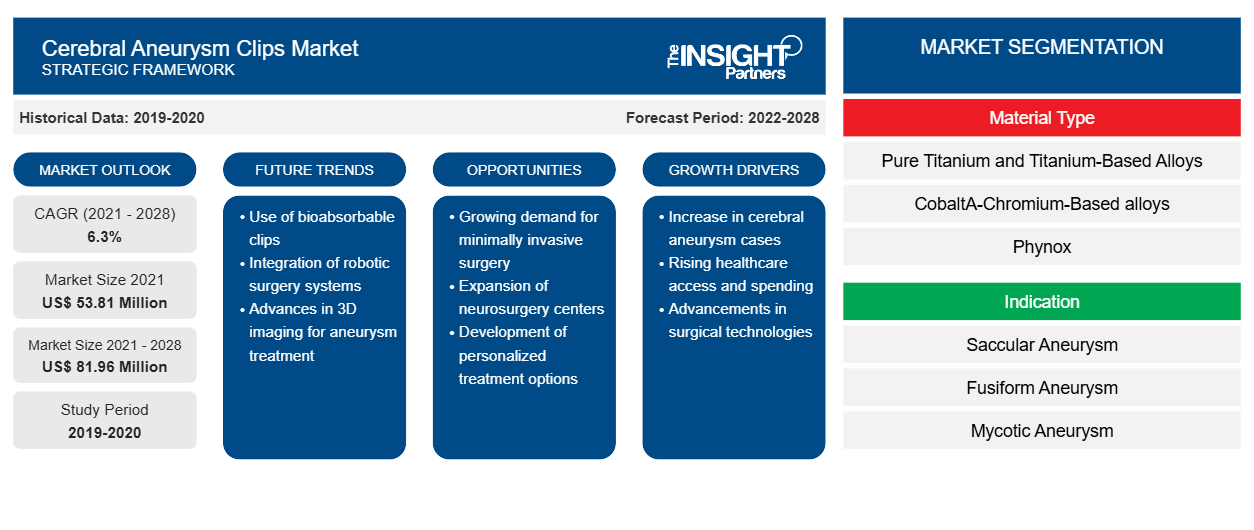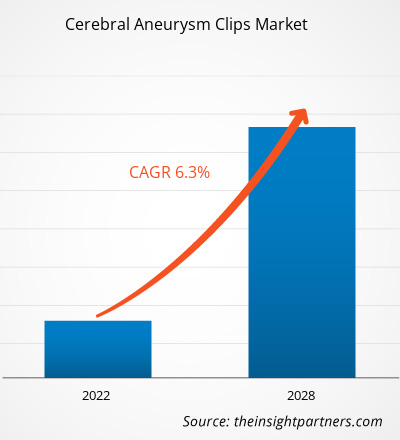The cerebral aneurysm clips market is expected to grow from US$ 53,810.74 thousand in 2021 to US$ 81,960.74 thousand by 2028. It is estimated to grow at a CAGR of 6.3% from 2022 to 2028.
A brain aneurysm or cerebral aneurysm is the development of a bulge in the brain's blood vessels. The bulge puts pressure on the nerves or brain tissues, and rupture or burst can cause brain bleeding, which can be fatal to a patient. Factors such as genetic conditions, arteriovenous malformations, untreated high blood pressure, and smoking cause brain aneurysms. Microsurgical clipping is the more established method of treating aneurysms. The first aneurysm ever treated by surgical clipping was performed at Johns Hopkins Hospital on March 23, 1937. During microsurgical clipping, a small metal clip is used to stop blood flow into the aneurysm. A craniotomy is performed to create an opening in the skull to reach the aneurysm. The clip is placed on the neck (opening) of the aneurysm to obstruct the flow of blood and it is left inside the brain after the procedures.
The report offers insights and in-depth analysis of the global cerebral aneurysm clips market, emphasizing various parameters including market trends, technological advancements, market dynamics, and competitive landscape analysis of global leading market players. It also includes the impact of the COVID-19 pandemic on the market across all major regions. The cerebral aneurysm clips market experienced the overall mixed impact of the COVID-19 pandemic, and hence, the market is still gaining traction and is expected to grow in the coming years. During this health emergency, delivering medical care to all patients became challenging for healthcare systems, which were overburdened due to the need to treat the vast number of COVID patients. Medical device companies also faced issues in managing their operations in 2020. However, with gradual relaxation in social restrictions and the resumption of elective procedures by hospitals, the demand for surgical procedures and related accessories has returned to normal levels.
Cerebral Aneurysm Clips Market -
Customize This Report To Suit Your Requirement
You will get customization on any report - free of charge - including parts of this report, or country-level analysis, Excel Data pack, as well as avail great offers and discounts for start-ups & universities
Cerebral Aneurysm Clips Market: Strategic Insights

-
Get Top Key Market Trends of this report.This FREE sample will include data analysis, ranging from market trends to estimates and forecasts.
Geography-Based Insights
By geography, the cerebral aneurysm clips market is segmented into North America (US, Canada, and Mexico), Europe (France, Germany, UK, Spain, Russia, Italy, and Rest of Europe), Asia Pacific (China, India, Japan, Australia, South Korea, Kazakhstan, and Rest of Asia Pacific), the Middle East & Africa (Saudi Arabia, the UAE, South Africa, and Rest of Middle East & Africa), and South & Central America (Brazil, Argentina, and Rest of South & Central America).
Market Insights
Surge in Geriatric Population drives the Growth of the Cerebral Aneurysm Clips Market
Cerebral aneurysms are common among the elderly populations, making the need for noninvasive vascular imaging more evident. Inconsistencies in life expectancy, cognitive dysfunction, vasculopathy, comorbidities, and rupture risks associated with heterogenous endovascular and surgical treatments contribute to a surge in the use of cerebral aneurysm clips. As per a research study conducted at the University of Maryland School of Medicine in 2021, the proportion of individuals aged 65 or above will reach 21% by 2050 from 8.1%. Several autopsy studies have correlated the increased prevalence of unruptured cerebral aneurysms with advancing age. Inagawa et al. from Shimane Prefectural Central Hospital, Izumo, Japan, examined 10,259 autopsies performed in New York. They found the incidence of unruptured cerebral aneurysms highest in patients aged 60 and above, with a peak prevalence of 1.2% in people aged 70 and above. Iwamoto et al., Kyushu University, Fukuoka, Japan, assessed 1,230 autopsies in Japan, reporting an overall increased prevalence of unruptured aneurysms with advancing age in women, with a peak prevalence of 14.5% in Japanese women of age 60–69 years. When reviewing magnetic resonance angiography studies in 8,696 asymptomatic Japanese adults, Harada et al. identified unruptured cerebral aneurysms in 3.2% of cases, and the prevalence increased with age in both men and women.
Many potential studies have assessed the occurrence of aneurysm rupture and its connection with old age. The overall risk of rupture per patient-year risk in the general population is 0.6–1.3%. Additional pertinent risk factors include a history of subarachnoid hemorrhage (SAH), hypertension, smoking, multiple aneurysms, and irregular morphology in the geriatric population. Some studies state that aneurysm size may be related to patient age. The Unruptured Cerebral Aneurysm Study of Japan (UCAS Japan) evaluated 6,697 cerebral aneurysms; 39.7% of patients aged 80 years and above had a size of 7 mm, or larger aneurysms were found in 21.4% of patients of age 50–59 years. Therefore, the ideal management of cerebral aneurysms in elderly patients provides scope for further developments and advanced care. Management is currently individualized, requiring the precise knowledge of natural history and risk of rupture that must be weighed against an individual's comorbidities, life expectancy, treatment-related risks, and success possibilities. Thus, with the growing elderly population, having a greater prevalence of aneurysms, companies in the cerebral aneurysms market are likely to grab significant growth opportunities in the coming years.
Material Type-Based Insights
Based on material type, the cerebral aneurysm clips market is segmented into pure titanium and titanium-based alloys, cobalt–chromium-based alloys, phynox, and others. In 2021, the pure titanium and titanium-based alloys segment is anticipated to hold the largest market share, however, the phynox segment is anticipated to register the highest CAGR in the market from 2022 to 2028.
Cerebral Aneurysm Clips Market Regional InsightsThe regional trends and factors influencing the Cerebral Aneurysm Clips Market throughout the forecast period have been thoroughly explained by the analysts at The Insight Partners. This section also discusses Cerebral Aneurysm Clips Market segments and geography across North America, Europe, Asia Pacific, Middle East and Africa, and South and Central America.
Cerebral Aneurysm Clips Market Report Scope
| Report Attribute | Details |
|---|---|
| Market size in 2021 | US$ 53.81 Million |
| Market Size by 2028 | US$ 81.96 Million |
| Global CAGR (2021 - 2028) | 6.3% |
| Historical Data | 2019-2020 |
| Forecast period | 2022-2028 |
| Segments Covered |
By Material Type
|
| Regions and Countries Covered |
North America
|
| Market leaders and key company profiles |
|
Cerebral Aneurysm Clips Market Players Density: Understanding Its Impact on Business Dynamics
The Cerebral Aneurysm Clips Market is growing rapidly, driven by increasing end-user demand due to factors such as evolving consumer preferences, technological advancements, and greater awareness of the product's benefits. As demand rises, businesses are expanding their offerings, innovating to meet consumer needs, and capitalizing on emerging trends, which further fuels market growth.

- Get the Cerebral Aneurysm Clips Market top key players overview
Indication-Based Insights
Based on indication, the cerebral aneurysm clips market is segmented into saccular aneurysm, fusiform aneurysm, and mycotic aneurysm. The saccular aneurysm segment held the largest market share in 2021; however, the mycotic aneurysm segment is anticipated to register the highest CAGR in the market from 2022 to 2028.
End User-Based Insights
Based on end user, the cerebral aneurysm clips market is segmented into hospitals, neurology centers, ambulatory surgical centres, and others. The hospitals segment held the largest market share in 2021; however, the neurology center segment is estimated to register the highest CAGR in the market from 2022 to 2028.
The cerebral aneurysm clips market players take up organic strategies, including product launch and expansion, to expand their footprint and product portfolio worldwide. Key players in the market are B. Braun Melsungen AG; Peter Lazic GmbH; Mizuho Medical Co. Ltd; Rebstock Instruments GmbH; KLS Martin Group; Integra Lifesciences Corporation; Ortho-Medical GmbH; and Adeor Medical AG.
Frequently Asked Questions
What is the regional market scenario of the cerebral aneurysm clip market?
Who are the key players in the cerebral aneurysm clip market?
Which Condition segment held the largest revenue (US$ Mn) in the cerebral aneurysm clip market?
Which segment led the cerebral aneurysm clip market?
What is meant by the cerebral aneurysm clip market?
During microsurgical clipping, a small metal clip is used to stop blood flow into the aneurysm. A craniotomy is performed to create an opening in the skull to reach the aneurysm in the brain. The clip is placed on the neck (opening) of the aneurysm to obstruct the flow of blood and remains inside the brain.
What are the driving factors for the cerebral aneurysm clip market across the globe?
- Historical Analysis (2 Years), Base Year, Forecast (7 Years) with CAGR
- PEST and SWOT Analysis
- Market Size Value / Volume - Global, Regional, Country
- Industry and Competitive Landscape
- Excel Dataset
Recent Reports
Testimonials
Reason to Buy
- Informed Decision-Making
- Understanding Market Dynamics
- Competitive Analysis
- Identifying Emerging Markets
- Customer Insights
- Market Forecasts
- Risk Mitigation
- Boosting Operational Efficiency
- Strategic Planning
- Investment Justification
- Tracking Industry Innovations
- Aligning with Regulatory Trends





















 Get Free Sample For
Get Free Sample For